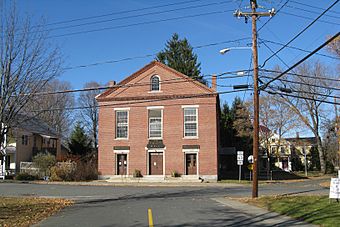Montague Center Historic District facts for kids
Quick facts for kids |
|
|
Montague Center Historic District
|
|

1858 Town Hall
|
|
| Location | Center, Main, North, School, and Union Sts.. Montague, Massachusetts |
|---|---|
| Area | 170 acres (69 ha) |
| Built | 1751 |
| Architect | multiple |
| Architectural style | Colonial, Greek Revival |
| NRHP reference No. | 01001236 |
| Added to NRHP | November 16, 2001 |
The Montague Center Historic District is a special place in Montague, Massachusetts. It protects the old village center, which looks much like it did in the 1800s. This area was once a busy place for both town government and small factories. It became part of the National Register of Historic Places in 2001.
Contents
Exploring Montague Center's History
Montague Center is one of five villages in the town of Montague. It sits in the central-southern part of the town. The Saw Mill River flows around the north and east sides of the village.
Main Street is the main road that goes through the village. It has a small bend in the middle. At one end of this bend, there's a triangular green space. Center Street goes east from here, and North Street goes north.
Old Signs and Landmarks
Further down Main Street, you'll find another smaller triangle. This is where Old Sunderland Road meets Main Street. In this green space, there's a tall signpost. It has several old signs from the 1700s. These signs point to nearby towns, and one of them might even be a trick!
How the Village Grew
Montague Center was originally the entire town, splitting off from Sunderland in 1752. The village really started to grow in the 1800s. This was because it had an early gristmill (a mill for grinding grain) and was where two important roads crossed.
Many of the most important buildings are on Main Street. You can also find them along North and Center Streets, which are next to the town common.
Important Buildings to See
Around the town common, there was a school and two churches built in the 1830s. The town hall, built in 1858, was also there. Today, that old town hall is the village library. The very oldest building in the district is the Root Tavern, which dates back to about 1734. It is now a private home.
The district also includes the Alvah Stone Mill. This mill is now known as the Bookmill. It is so important that it is listed separately on the National Register of Historic Places. You can find it right on the Saw Mill River.



